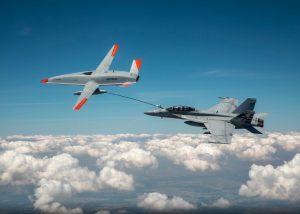The Navy requested Congress let it move hundreds of millions of dollars related to the MQ-25 Stingray unmanned carrier-based tanker aircraft funds for fiscal year 2023 due to delays in delivery of engineering and manufacturing development (EMD) aircraft.
As part of a June 30 $4 billion omnibus reprogramming request by the DoD comptroller, the Navy wants to decrease MQ-25 other aircraft procurement funds by $580 million due to these delays as well as obsolescence issues, spending only $168 million of the approved $697 million.

The reprogramming request explained that funds are available because Milestone C and the Low Rate Initial Production (LRIP) contract award are being delayed from fiscal years 2023 to 2025.
“Delays in the delivery of EDM air vehicles, as well as emerging avionics obsolescence issues that prevented the procurement of critical aircraft systems required for production, have overly pressurized the program’s aggressive schedule and resulted in a re-evaluation of the planned FY 2023 entrance into LRIP,” the request said.
In April, Rear Adm. Stephen Tedford, Program Executive Officer for Unmanned Aviation and Strike Weapons, revealed the revised MQ-25 IOC schedule was pushed back a year to 2026 due to production maturity challenges (Defense Daily, April 13).
DoD noted previously the FY ‘24 budget request included four MQ-25 LRIP procurements between FY 2023 and 2024, but now the Navy intends to zero both out so LRIP begins in FY 2025 and at a higher rate of four aircraft per year.
Instead, the Navy wants to add $513 million to the approved $254 million for the MQ-25 system development and demonstration (SDD) account under research, development, test and evaluation funds.
This would raise the SDD account to $768 million.
DoD argued that it requires funds to continue EMD work for the MQ-25 given “Schedule delays in the delivery of EMD air vehicles have extended the EMD program and have delayed entry into Low-Rate Initial Production.”
It said funds are also needed now for obsolescence redesign efforts “required to produce a useable end item for an air vehicle post EMD.”
The Navy sad it would use this additional $513 million to specifically procure additional System Demonstration Test Articles (SDTAs) needed to maintain production continuity and minimize impacts to the MQ-25 fielding and support testing and qualification of the obsolescence redesign; conduct obsolescence redesign; develop or procure tooling to produce test items and related production line requirements; and perform necessary developmental nonrecurring engineering (NRE) efforts, and sustainment strategy.
Boeing [BA] is the MQ-25 contractor. It has been using its T-1 test asset in ground and flight tests.
Boeing first won the initial $805 million engineering and manufacturing development contract in 2018 for the design, development, building, testing and verification of the first four aircraft (Defense Daily, Aug. 30, 2018).
This was followed by a 2020 $85 million modification for three more system demonstration test article aircraft (Defense Daily, April 3, 2020) and a 2022 $47 million advance acquisition contract to prepare to build and deliver the planned four LRIP Lot 1 aircraft (Defense Daily, Sept. 30, 2022).
The Navy plans to procure 76 MQ-25s total, including the four engineering development models and three system demonstration test articles.
The MQ-25 IOC has moved around repeatedly, first set for FY 2026 before the Navy pushed it up to 2024, then delayed one year to 2025 and then sent back to the original date of 2026.
In April, Tedford said after the current fixed-side determinate assembly production schema dealing with challenges the program will move to “Stingray to the Fleet,” where it fields three to five platforms from an unnamed aircraft carrier in a permissive environment.
The MQ-25 is expected to be able to pass 15,000 pounds of gas at up to 500 miles from the carrier at an altitude of 25,000 feet to replace the F/A-18 E/F Super Hornets currently conducting tanking roles.